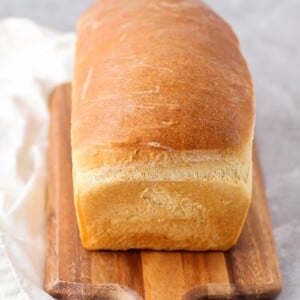White Bread Recipe
This simple white bread is perfect for both the bread novice and pro baker. It's tender, delicious, and SO easy!
Servings: 2 loaves
Ingredients
- 2¼ cups warm water (110–115°F)
- 2¼ teaspoons rapid rise yeast (1 packet)
- 3 tablespoons +½ teaspoon sugar, divided
- 5-6 cups bread flour, divided
- 1 tablespoon salt
- 2 tablespoons canola oil
Topping
- butter (optional)
Instructions
- In a large bowl, dissolve yeast and ½ teaspoon sugar in warm water; let stand until bubbles form on the surface.
- In a large bowl, whisk together 3 cups flour and remaining 3 tablespoons sugar and the salt.
- Stir oil into yeast mixture, then pour into flour mixture and mix until smooth. Stir in remaining flour ½ cup at a time to form a soft dough.
- Turn dough onto a lightly floured surface and knead until smooth and elastic, 8-10 minutes. Place in a large, greased bowl, turning once to grease the top. Cover and let rise in a warm place until doubled in size, 1½-2 hours.
- Punch dough down and place onto a lightly floured surface. Divide dough in half and shape each piece into a loaf.
- Place in two greased 5-x-9-inch loaf pans. Cover and let rise in a warm place until doubled, 1-1½ hours.
- When ready to bake, preheat the oven to 375°F.
- Bake loaves for 26-34 minutes, or until golden brown and bread has reached an internal temperature of 200 degrees F (bread should sound hollow when tapped).
- Remove bread from pans and transfer to wire racks to cool. Brush tops with butter while warm.
Video
Notes
Recipe Tips.
- Homemade bread flour: add 1 to 1.5 teaspoons of vital wheat gluten to a 1-cup measuring cup, then fill the remainder of the cup with all-purpose flour. Sift the mixture together before using.
- I like to bloom rapid rise yeast in water first to ensure it's viable. However, you can skip the blooming step and mix it directly with the flour. If you use active dry yeast, it must be bloomed in water.
- You'll know your bread dough is properly proofed when it has visibly doubled in size and looks puffy. To confirm, gently press with a floured finger; the indent should remain or spring back slowly halfway.
- You can knead using the dough hook attachment on a mixer for 5 to 8 minutes on a low to medium-low speed. Do not overknead!
- After the first rise, punch down the dough, shape it into a loaf, and place it on a parchment-lined baking sheet in the freezer until solid. Once frozen, remove from the baking sheet, wrap each loaf tightly with plastic wrap, and store in a freezer-safe Ziploc bag for 3-4 months
- When ready to bake, remove the plastic wrap from the frozen loaf and place it in a greased baking pan. Lightly spray one side of a new piece of plastic wrap with cooking spray and place it, sprayed side down, over the pan. Refrigerate overnight to thaw, then move the pan to the counter to finish rising until doubled in size. Once fully risen, remove the plastic wrap and bake as usual.
Nutrition
Serving: 1loaf | Calories: 1381kcal | Carbohydrates: 254g | Protein: 43g | Fat: 20g | Saturated Fat: 2g | Polyunsaturated Fat: 6g | Monounsaturated Fat: 10g | Trans Fat: 0.1g | Sodium: 3515mg | Potassium: 443mg | Fiber: 11g | Sugar: 23g | Vitamin A: 6IU | Vitamin C: 0.04mg | Calcium: 61mg | Iron: 3mg
